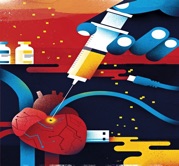PR for Innovative Medical Research
Promoting innovative science and human-based predictive models.

Journalists:
For press enquiries,
call 07739531256.
23/08/2014
Science news
The Guardian
Think of a world where more new medicines are available more quickly, more safely and with few, if any, animals used in research. Think of a world where you know for sure that the drug you are prescribed is safe for you. This is what researchers at some of the world's leading universities are trying to bring about.
Academics from disciplines as far apart as computer science and biology are growing mini-human hearts in a lab or creating a model of the human biological system on a common computer chip. Their aim is to bring to an end to what has been called the "pharmaceutical ice age", an era of ever more research but fewer medicines reaching the shelves of Boots.
According to the Association of the British Pharmaceutical Industry, it can take up to 12 years and 7bn pounds before a new medicine reaches the high street. For that one medicine, 25,000 chemicals will have been tested, 25 potential drugs will have had human clinical trials, perhaps five will have been passed by the regulators and only one will have been marketed by a drugs company. Even after that, a good number of drugs have to be withdrawn owing to previously undetected side-effects.
For some, the fault for this freeze is due to the pharmaceutical industry's obsession with mergers and acquisitions or a culture that inhibits innovation. For others, it is a sign that perhaps there just aren't many chemical compounds that can interact with the body and have a positive effect; or even that the tools scientists use during discovery and early-stage testing mean the wrong drugs go to human trials.
While animal testing is a regulatory requirement for any new drugs, it remains a fairly unpredictable guide to how a drug will react in humans. Testing drugs on cells in a petri dish allows much higher dosages than with an animal, but is an unreliable guide as to how they might interact with the human body. Virtual computer models of the likely impact of a drug have also, up to now, largely been based on the reactions of a single cell.
Now scientists are trying to use new technology to make drug testing faster, cheaper - and more accurate - by modelling more closely how a chemical interacts with the human body. They hope to do this to the point where a drug could be declared safe for a certain section of the population or even personally safe for you.

Photograph: Alamy

Illustration by Dale Edwin Murray.
We are in a pharmaceutical ice age where fewer drugs are being developed